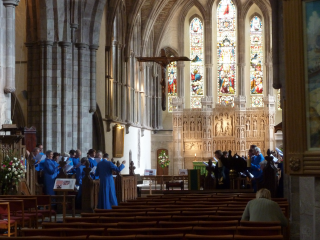
 F YOU ARE ANYTHING LIKE ME, you are loath to spend any of your choir rehearsal time doing anything but rehearsing. Next Sunday is always approaching and the liturgical calendar waits for no one. Sometimes, though, spending a little time with organization within rehearsal can same immeasurable amounts of time otherwise spent correcting tonal issues. Intentional seating of your choir members is one such technique.
F YOU ARE ANYTHING LIKE ME, you are loath to spend any of your choir rehearsal time doing anything but rehearsing. Next Sunday is always approaching and the liturgical calendar waits for no one. Sometimes, though, spending a little time with organization within rehearsal can same immeasurable amounts of time otherwise spent correcting tonal issues. Intentional seating of your choir members is one such technique.
James Jordan outlines this technique in his invaluable text, Evoking Sound: The Choral Rehearsal. Its goal is to create a choral blend of your singers using the complementary natural overtones of each voice.
Start with “principle” in each section (if you sing divisi, do it with the divisions individually). The principle is the voice type in the section that you would most like to represent the whole section’s sound. Next, seat one singer from the section next to the principle and have them sing the first phrase of “My Country ’tis of Thee” together, making no attempt to blend. Try this with each singer in the section coupled with the principle, and choose one that sounds the best naturally with him or her. Repeat this process, having all the seated singers sing together, and seating whomever sounds best in the next position. When all the singers of a section have been seated, shift the last singer in line to the other end, next to the principle. Repeat this process for all sections of the choir.
The first time I tried this technique, I was skeptical. I was going to forfeit a solid 20 minutes of rehearsal. What I found, however, was a natural, choral sound with many of our previous intonation problems ironed out. Furthermore, the strong singers of the choir were fairly well spaced out in each section, giving everyone a bit more confidence.
One other arrangement Jordan encourages in his book is a different arrangement of sections in the choir. I was used to a fairly standard setup: Sopranos to my far left, Basses next to them, then Tenors, and Altos on my right. What Jordan recommends, though, is a 4-row setup, with the sections seated by row from back to front: Basses, Tenors, Sopranos, then Altos. Again, this setup gave an outstanding choral blend, since everyone benefits from hearing the Basses, and the Altos benefit from hearing everyone.
As hesitant as I was to spend my precious rehearsal time on something as mundane as seating the singers, the time was well spent, and the time was easily made up since there was much less time needed correcting pitch and intonation problems. Setting up your choir in an acoustically advantageous position is just one basic way to maximize your rehearsal time and improve your sound.

